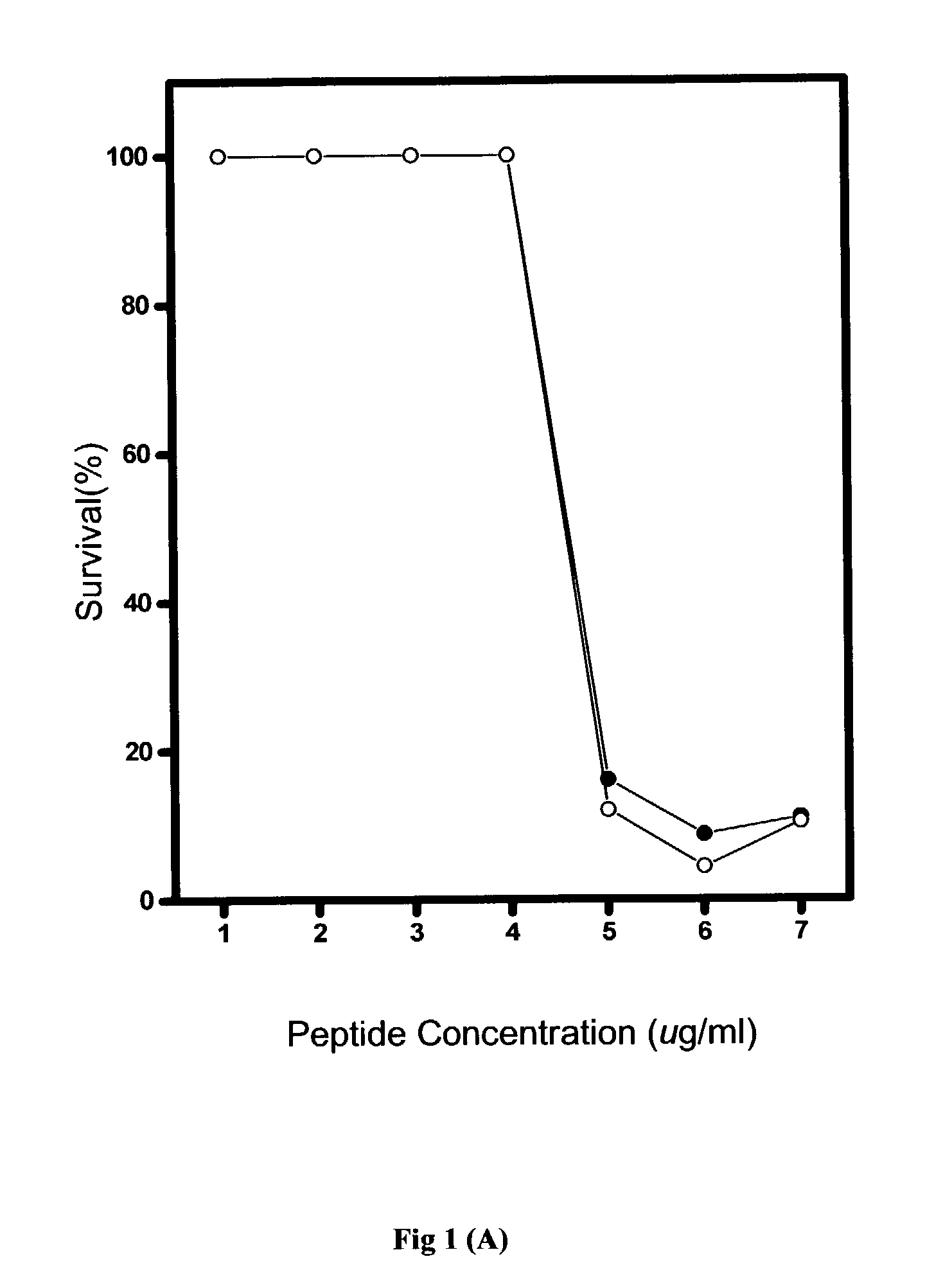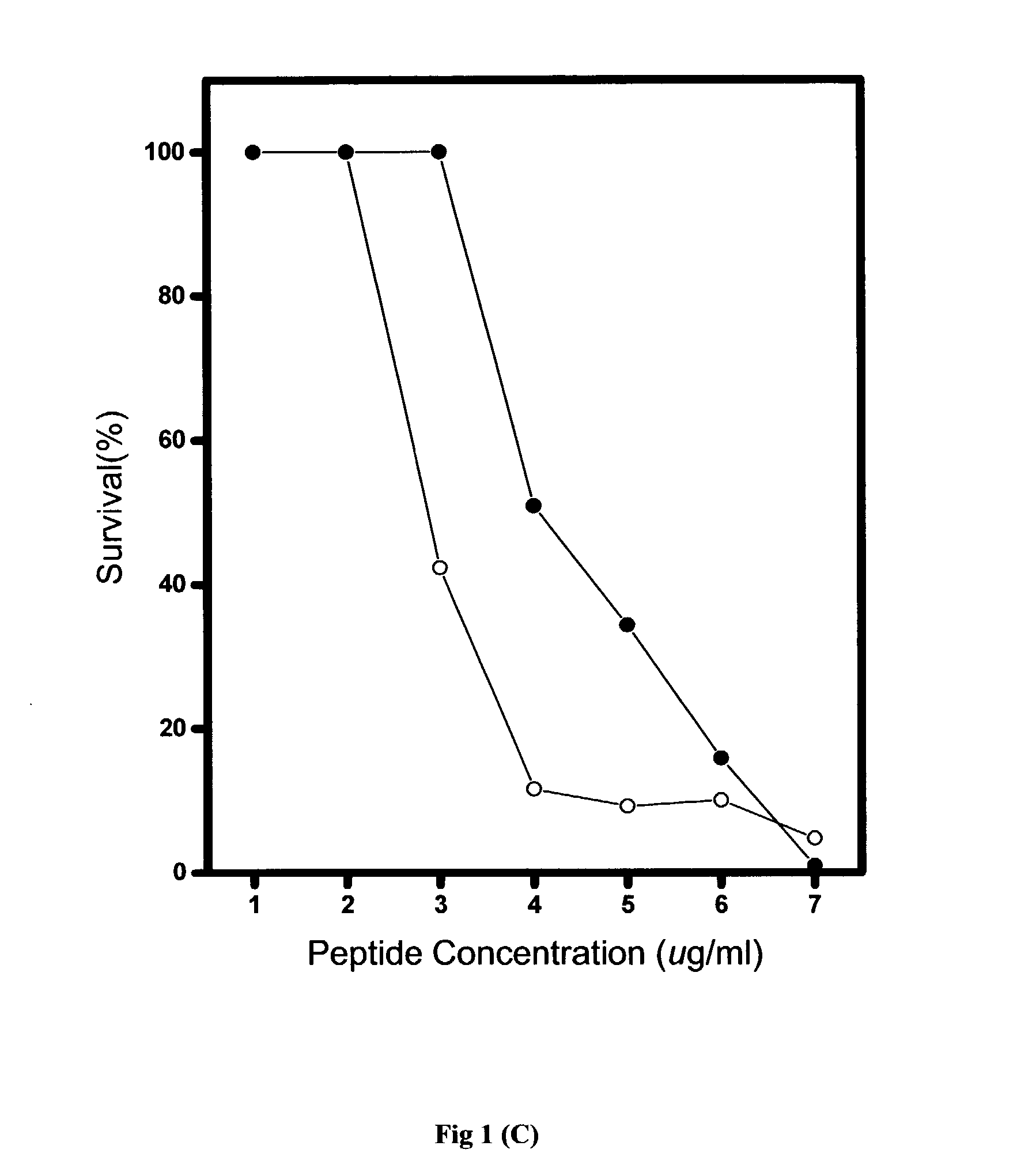Antimicrobial peptides with reduced hemolysis and methods of their use
a technology of antimicrobial peptides and hemolysis, which is applied in the direction of tripeptides, cyclic peptide ingredients, saccharide peptide ingredients, etc., can solve the problems of limiting their therapeutic potential and limiting their accessibility to protease activity
- Summary
- Abstract
- Description
- Claims
- Application Information
AI Technical Summary
Benefits of technology
Problems solved by technology
Method used
Image
Examples
example 2
Detect the Activities of the Peptides In Vitro
[0067] Generally, the in vitro antimicrobial activities of antimicrobial agents were tested using standard NCCLS bacterial inhibition assays, or minimum inhibition concentration (MIC) tests. The MIC value is the lowest concentration of peptide at which the visible growth of test organisms is inhibited and reduced. The test organisms used in the MIC assays are as listed in Table 2.
2TABLE 2 Test strains used for MIC determination Organism Source Bacillus. substilis ATCC 6633 Staphylococcus aureus ATCC 9144 Staphylococcus epidermidis ATCC 12228 Staphylococcus aureus ATCC 29737 Bacillus pumilus ATCC 14884 Bacillus cereus ATCC 11778 Pseudomonas aeruginosa ATCC 29213 Staphylococcus aureus ATCC 29213 E. coli ATCC 25922
[0068] Briefly, overnight cultures of the test organisms were diluted to produce an inoculum containing approximately 10.sup.5 colonies in Meuller-Hinton broth (MHB). From the peptide stock solution, serial two-dilutions of the pe...
example 3
Membrane Permeabilization Assays
[0070] The outer membrane permeabilization activity of the peptide variants was determined by the 1-N-phenylnaphthylamine (NPN) uptake assay, using intact cells of E. coli. NPN performs weak fluorescence in aqueous environment but exhibits strongly in hydrophobic environment. Since NPN is hydrophobic, it provides a direct measurement of the degree of outer membrane permeability. E. coli takes up little or no NPN in a general condition. In the presence of permeabilizer compounds (EDTA, polymyxin B, Neomycin, or antimicrobial peptides), NPN partitions into the bacterial outer membrane and results in an increase in fluorescence. Briefly, use 1 ml of overnight culture to innoculate 50 mls of media and incubate 37.degree. C., shaking. Grow to OD.sub.600=0.4-0.6. then spin down cells (3500 rpm, 10 min.). Wash and re-suspend in buffer to OD.sub.600=0.5. Record OD.sub.600. Add 1 ml of cells (OD.sub.600=0.5) to cuvette and measure 2-5 seconds. Add 20 ul NPN 0....
example 4
Characterization of the Environment of the Trp Resides
[0071] Because of the sensitivity of tryptophan to the polarity of its environment, it has been used for polarity and binding studies. Fluorescence emission spectra were recorded on an LS-55 spectrofluorimeter [Perkin-Elmer] Measurements were performed between 300 and 450 nm at 1 nm increments using a 5 mm quartz cell at 25.degree. C. The excitation wavelength was set to 280 nm with both the excitation and emission slit widths set to 5 nm. In the phosphate buffer, the series of antimicrobial peptides exhibited an emission maximum at 357 nm. In the presence of SDS, they displayed 8 nm blue shift of the emission maximum with a concomitant increase in intensity. The results indicated that the tryptophan side chains had moved into a more hydrophobic environment. The results of this study are shown in FIG. 3.
PUM
| Property | Measurement | Unit |
|---|---|---|
| molecular mass | aaaaa | aaaaa |
| flow rate | aaaaa | aaaaa |
| wavelength | aaaaa | aaaaa |
Abstract
Description
Claims
Application Information
 Login to View More
Login to View More - R&D
- Intellectual Property
- Life Sciences
- Materials
- Tech Scout
- Unparalleled Data Quality
- Higher Quality Content
- 60% Fewer Hallucinations
Browse by: Latest US Patents, China's latest patents, Technical Efficacy Thesaurus, Application Domain, Technology Topic, Popular Technical Reports.
© 2025 PatSnap. All rights reserved.Legal|Privacy policy|Modern Slavery Act Transparency Statement|Sitemap|About US| Contact US: help@patsnap.com



